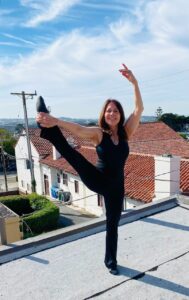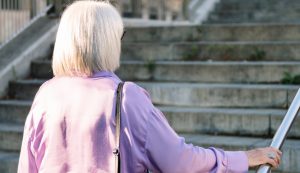Speaking with Loretta one can’t help but notice her vibrant energy and power. A lifelong dancer, she has pushed her body to the limit teaching, taking classes, and dancing professionally for many years.
Her journey into the world of dance began at an early age when her mother enrolled her in a dance class, aiming to correct her inward-turning hips. Loretta recalls her mother telling her about the doctor putting her in special shoes attached by a bar to correct her turned in hips. However, she thinks that this process may not have corrected the problem, which later was suspected to be hip dysplasia.
Dancing and teaching became her way of life, with a rigorous schedule of at least five days a week, even as she reached her mid-fifties—a period when many people consider slowing down. Loretta, with her trademark smile, proudly remarks that she often finds herself as one of the older members in the class or performance group, yet she maintains an astonishing level of flexibility, strength, and effortlessly keeps pace with the younger dancers.

Today, I dance without restraint, free from the nagging feeling of discomfort, relishing every moment, and enjoying my passion to the fullest.
Eight years ago, Loretta’s unwavering commitment to dance led her to discover what she thought to be a pull in her groin area. Her initial assumption was it was a minor injury. However, her doctor’s diagnosis was unexpected: “You are over 50, and you have arthritis.” Furthermore, the doctor suggested hip surgery to address potential hip dysplasia that may have exacerbated the issue. Stunned by this revelation, Loretta sought multiple opinions from physical therapists and orthopedic specialists. The consensus was that physical therapy could offer little, and the alternative was cortisone shots deep into the hip socket to alleviate the pain.
It was through a lifelong friend that Loretta heard of Dr. Mast who had performed a double hip replacement for her friend’s client who was an avid runner and athlete, and was delighted with the results, swiftly returning to running. Loretta also had prior experience with Dr. Mast early in his practice when he treated her son’s broken leg, further bolstering her confidence in his expertise.
Loretta vividly recalls her consultation with Dr. Mast, where he showed her a video of another dancer who had undergone one hip replacement and later had her other hip replaced, and went back to teaching, dancing, and professionally performing. With the convergence of these factors and her trust in Dr. Mast, Loretta took the decisive step of scheduling the surgery.
After the procedure, Dr. Mast shared an honest assessment with Loretta: “Yours was the worst hip I encountered today. It appeared to be hip dysplasia, but the extent of arthritis and damage made it difficult to discern.”
Just two days post-surgery, Loretta’s husband recorded a video of her performing the mambo, swaying her hips – no walker needed – an act of joy and assurance that the surgery had indeed been a success. Although it took another four months before Loretta returned to the dance floor, she has since reclaimed her passion, dancing vigorously up to five times a week, encompassing lessons, teaching, performances, and choreography.
Loretta’s journey is a living testament to the transformative power of hip replacement surgery. In the post-surgery phase, she experienced a profound awakening: “I danced for eight years with a sense of caution, unconsciously safeguarding my body. It wasn’t until after the surgery, during my complete recovery, that I realized the extent of my restraint. When we carry the knowledge of an injury, we instinctively protect that part of our body. Today, I dance without restraint, free from the nagging feeling of discomfort, relishing every moment, and enjoying my passion to the fullest.”
Loretta’s story exemplifies the extraordinary impact that hip replacement can have on a person’s life, reviving their passion and enthusiasm for the art of movement.









